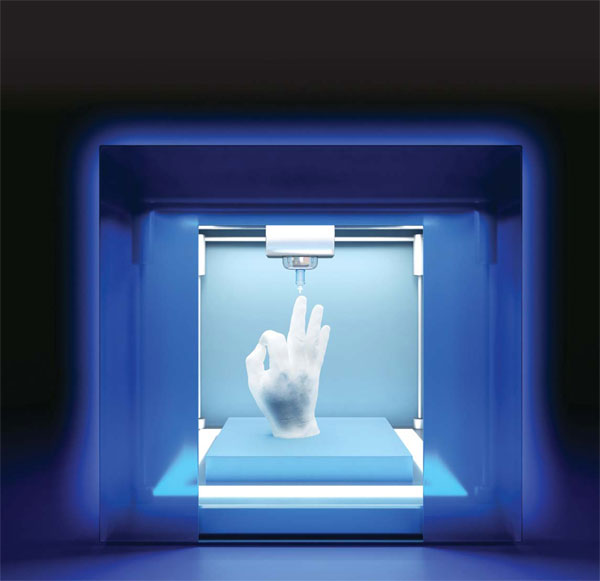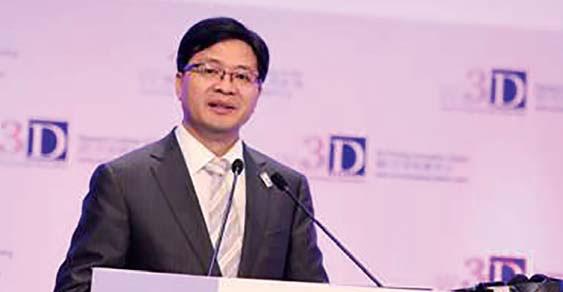Dawn of a new dimension
Updated: 2015-01-23 10:38
By Kristine Yang for China Daily(China Daily Europe)
|
|||||||||||
After decades of development, 3D printing is now ready to revolutionize manufacturing
In October, the southern Chinese city of Changsha launched an industrial park. What sets this park apart from other manufacturing centers is that it is poised to play a key role in the growth of innovative Chinese technology.
The development is China's first hub for the technology, and was established with an immediate goal to produce 100 3D printers, and to triple the number of devices by 2016. Taking Changsha's lead, the cities of Wuhan and Zhuhai have since announced their plans to develop similar industry hubs.
Other countries in the region are also focusing on this fast-growing technology.
Over the next five years, Singapore plans to invest $500 million to boost the country's skills in advanced manufacturing, heavily focusing on 3D printing.
Companies in Japan are already marketing inexpensive desktop 3D printers while South Korean conglomerates are using the technology widely.
After decades of development, 3D printing has emerged as a viable and affordable technology, increasingly used by both the private and public sector. While there remain problems to be worked out, it could eventually revolutionize the manufacturing sector that many countries in Asia depend on for economic growth.
"3D printing has been around since the 1980s and has been expanding into mass production and specialized manufacturing since then," says Maria Smith, head of law firm Baker & McKenzie's trademarks practice in Hong Kong.
"The business is growing rapidly. In 2013, the (global) market size was estimated at $2.5 billion. It is projected to reach $16.2 billion by 2018."
3D printing, also known as additive manufacturing, has already been used to produce cars, buildings, guns and even body parts.
"In the medical field, Chinese scientists have gone a step further, using live tissue to create organs and print ears, livers and kidneys," adds Smith.
As it becomes increasingly accessible and affordable to consumers, the technology is making it possible for products to quickly reach the market with less labor-intensive production required.
But these benefits are also a cause for concern. As 3D printing allows for the quick and easy copying of products, it is, in turn, presenting fresh challenges for regulators that have yet to adapt to the technology and for companies seeking to protect their intellectual property.
Once prohibitively expensive, the technology that makes 3D printing possible has evolved substantially.
Hewlett-Packard in October introduced a 3D printing technology 10 times faster and 10 times more precise than existing technologies. The Multi Jet Fusion 3D printer is set to launch in 2016.
In November, General Electric announced its plans to invest $32 million in developing an additive manufacturing facility in the United States - a factory that operates using 3D printers.
In Asia, XYZprinting, a company backed by Taiwan's electronic manufacturing conglomerate Kinpo Group, launched the world's first all-in-one 3D printer with built-in scanner.
The da Vinci 1.0 AiO, weighing around 20 kilograms and resembling a large microwave, is available to buy for $799 through e-commerce websites including Newegg.com and Amazon.
A 3D printer introduced in late 2014 and developed by China Aerospace Science and Industry Corp, is due to be mass-produced and available later this year.
Li & Fung, a Hong Kong-based consumer goods design, logistics and distribution company, has in recent years run a series of 3D printing initiatives. In 2013, it carried out Asia's first in-store 3D printing retail experience at a Toys R Us outlet in Hong Kong. Li & Fung has also explored the possibility of teaming up with other companies like Samsung to drive the technology further.
"With nearly 30 years of development, 3D printing technology is already quite mature," says Luo Jun, secretary-general of the World 3D Printing Technology Industry Alliance.
"It has been widely used for design in creative industries and printing teeth or bones in the biomedical field," adds Luo, who is also executive-president of the China 3D Printing Technology Industry Alliance. "Manufacturing and the aerospace industry use it to print complex moldings and components, or customized buildings."
Paul Shao, CEO of Trustworthy (Beijing) Technology, a 3D printer company that distributes systems developed by brands including 3Shape and Roland, says the region is quickly finding its way with 3D technology.
"In Asia, the markets in Japan, China and South Korea are more mature in terms of 3D printing, but we can see many regions like Southeast Asia and middle Asia are joining the game in trading and applications," Shao says.
A country's 3D printing capacity is closely linked with its competitiveness in traditional manufacturing, he adds.
"Compared with the US, Europe and Japan, China is still at an infant stage in terms of innovative design, precision processing and economic power. We have much space to grow in many key technology areas such as laser and materials. But we are getting closer and closer," says Shao.
The evolution of supply chains is also driving the development of 3D printing. More brands are using just-in-time supply chains that make good use of the technology, getting products manufactured more quickly and into the hands of consumers.
In other regional markets, many of which rely on labor-intensive manufacturing for economic growth, the technology is less mature. Examples are Thailand and Malaysia, two middle-income countries moving up the value chain.
Thailand imports all of its 3D printers from the US, Canada or Germany because it lacks the technology to make its own, despite being a prodigious supplier of microchips.
But as Luo points out, the use of 3D technology in the region is likely to gather more pace.
"3D printing technology has been growing fast in China with more than 100 companies involved in industry, biomedicine, creative (industries), architecture, materials and software. China's 3D printing market has seen more than 40 percent growth for two consecutive years," says Luo.
China's Ministry of Science and Technology has included 3D printing technology in the National High-Tech Research and Development Program, which sponsors research in key high-technology fields. The Ministry of Industry and Information Technology (MIIT) is accelerating the process to launch support policies.
"The Ministry of Education is planning to bring 3D printers into schools," Luo adds.
In September, MIIT announced it was working on a plan to promote the industry.
"We will see greater usage of 3D printing with increased affordability encouraged through government initiatives," says Andy Leck, managing principal and head of the IP practice at Wong & Leow, a member firm of Baker & McKenzie in Singapore.
"Key examples of these initiatives include the Singapore government's Productivity and Innovation Credit scheme and the investment of $500 million over five years as part of the government's Future of Manufacturing program," he says.
All this attention, however, may be creating a bubble. After a boom in raising capital through 2013, many 3D printer manufacturers have performed badly, particularly in terms of their stock price.
The share prices of some major 3D printer producers have dropped significantly over the past year. US-based ExOne fell from $66 in January to $21 in November, Stratasys slid from $134 to $105 and 3D Systems plunged from $96 to $36. In the same period, Germany's Voxeljet dropped from $47 to $12.
A number of linked companies listed in China's A-share market, such as those involved in robotics, have not performed well, either.
One exception is Guangdong-based polymer materials company Silver Age, which saw its value grow from 6.16 billion yuan ($994 million) in January to 17.45 billion yuan in November.
And if IP issues and fears of a bubble are not enough of a concern, the industry in Asia still faces a couple of other challenges including the high cost of materials and a dependence on imports. Another hurdle is the lack of a mature business model for companies in the sector.
"The industry still has not seen a mature business model," says Luo from the printing technology industry alliance. "Many companies are following the path of traditional manufacturing by selling the printers. That is a great challenge for the industry."
What are available on online shopping platforms like Taobao and JD, he says, are the most basic desktop printers, but this cannot greatly push the wide use of the technology.
"A mature business model must integrate education and application with a public service platform."
Ultimately, the industry will evolve when it can mesh the technology with existing manufacturing techniques.
Shao of Trustworthy (Beijing) Technology says without the cost of molding, the cost is comparable with traditional manufacturing.
"But some clients' product portfolio is limited," he says. "They probably use the same mold for decades for mass production. Then 3D printing cannot compete with traditional manufacturing in terms of the cost per item."
Luo says the 3D technology is not something that can be easily substituted as there are challenges from high costs, slow printing speeds and limited options of materials.
"That's why proper positioning is crucial for development in Asia," he says.
Nevertheless, the technology has the potential to eventually revolutionize manufacturing.
"We believe traditional manufacturing and 3D printing can complement each other instead of replacing each other," Luo says. "Only with the full integration of the two technologies will there be a third industrial revolution."

|
Provided to China Daily |
|
Luo Jun, secretary-general, World 3D Printing Technology Industry Alliance. |



(China Daily European Weekly 01/23/2015 page14)
Today's Top News
China offers Swiss $8b quota for yuan trading
Best team China in decade carries countrymen's hope
Russia says DPRK sent positive signal on Kim visit in May
Australia PM quashes rumours of unrest as 'nonsense'
China aims for stronger links with fragile Europe
China to instill national characteristics in think tanks
Shanghai govt releases report on stampede tragedy
Fake condoms, Viagra, seized and online network shut down
Hot Topics
Lunar probe , China growth forecasts, Emission rules get tougher, China seen through 'colored lens', International board,
Editor's Picks

|

|

|

|

|

|







